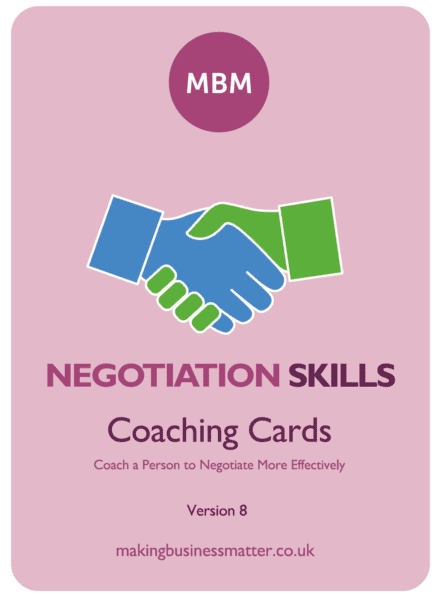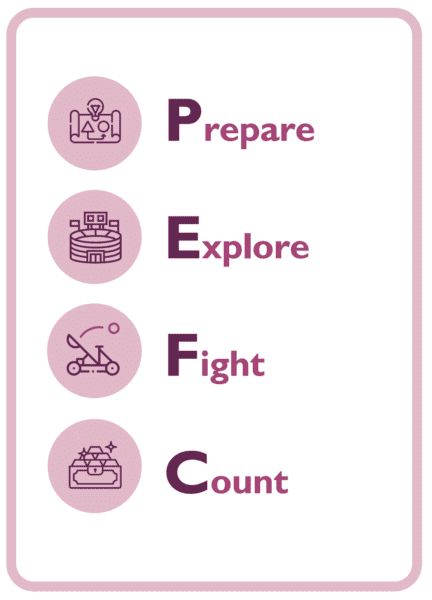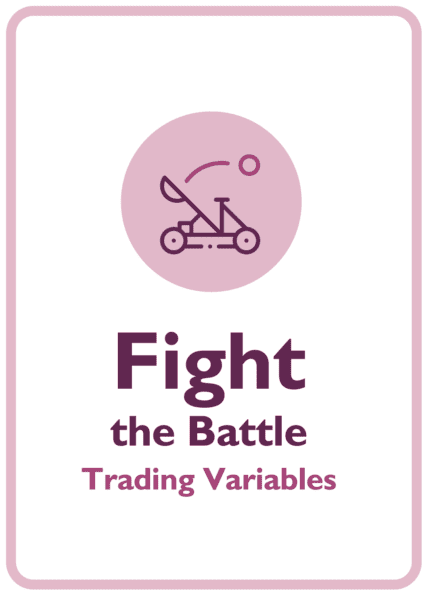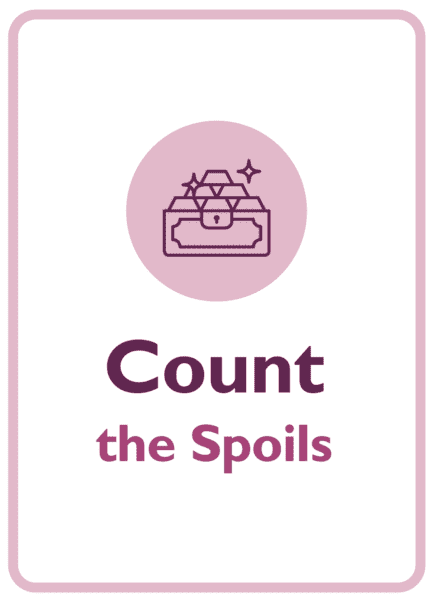When it comes to the Negotiation Stages, there is no one right answer. Only the best answer for you.
Many people have arrived at various models showing that there are 3, 4, 5, 6, or even 7 stages of negotiation. They are all correct.
It really depends on what will help you. In this article, I’ll share with you a model of 4 stages, and then I’ll also discuss how this could be fewer, or more stages, as well. It really is about you – whatever helps you to improve your ability to negotiate.
What are the Stages of Negotiation?
Our preferred model is that of 4 stages of negotiation. So, in answering your question of ‘What are the stages of negotiation?’, my answer is that there are 4 and they are:
-
- Prepare
- Explore
- Fight
- Count
You can see these stages in our negotiation skills coaching cards:



Explain Each Stage of the Negotiation Stages
1. Prepare for Battle

Most people prepare for negotiation in two ways; either they ‘have a bit of a think’ & hope it goes well, whilst panicking & worrying, or others start with Powerpoint & begin building slides. Both of these are not the most effective ways to prepare for a negotiation. This is because ‘having a think’ is like having a dream without an action plan – It’s just hope. And using Powerpoint is like using a toffee hammer to bang in a nail. It might work, but I doubt it.
Preparing is all about 3 things; Improving your confidence, knowing your wish & walk-away points, and having tradeables. Plus, having the right questions to ask and the right tools to use would be good too. Effective preparation uses our unique squaredance template. This is ideal for preparing for a negotiation. Find out all about how to prepare for a negotiation.
Sticky Learning ® is 7 times more effective than 1-day training courses. Plus, you will get a Chain of Evidence proving your Return on Investment. Discover soft skills training that changes behaviours long term.

2. Explore the Arena

Most amateur negotiators miss this stage. They go straight to the next stage of the negotiation and find themselves in a deadlock or stalemate. This stage is not about agreeing to anything, it is about being a detective, asking questions and finding out what the other party wants. You may think that they want a better price, and they probably do, but what else is important to them? Find out using open questions and even better questioning techniques.
Consider the scenario of being on a car forecourt. The salesman comes over and starts waffling on about the lovely red two-seater sports car that you are looking at. ‘Low mileage, only two owners, blah, blah, blah…’. If only he had asked a few questions, he’d know that you had 4 kids and a people carrier was what you really need. The sportscar is a daydream. This stage of the negotiation is similar. Don’t assume. Ask.
3. Fight the Battle

A Learner since said to me during a negotiation skills training course, ‘You are setting us up to combative by saying, Paul Versus Mike’. I replied, ‘If you think that a negotiation is not combative then you will lose’. The other party want what you have and want to get a bigger slice of the pie than you. Yes, they may aim for win:win. In their minds you’ll still win, just it will be ‘WIN:win‘. Negotiation is a form of conflict and if you think the other party will go easy on you, you’ll lose before you start. That does not mean that you are aggressive, rude, or disrespectful. It does mean that you are prepared and prepared well.
This stage is all about the tradeables. Without them, your negotiation will stall. Tradeables, the gives and takes, are the grease that keeps the negotiation engine running. You can find out about tradeables and 88 of them. The tradeables are a key part of your stage 1 preparation and as such are included in your Squaredance template.
4. Count the Spoils

Furthering our battle metaphor, we use ‘Count the Spoils’ for stage 4 of the negotiation. You can imagine after a medieval war the king and his merry men counting the winnings – chests of gold coins. This is similar, though this stage is in two parts; during the negotiation summarise what you have agreed, and then after the negotiation, know what you got.
Summarising is key, and cannot be done enough because often negotiations have fallen apart afterwards because one party received the other party’s email and thought, ‘There’s no way we agreed to that’, and so the negotiation starts all over again. Summarise as you go, and don’t be tempted to either summarise in your favour or email a summary that has only some of what was agreed, or now includes some stuff that wasn’t agreed.
The second part – knowing what you got is about understanding how you performed vs your objectives (wish & walk-away), and also it is about ensuring you get what you agreed. Some would say that the negotiation is only half the battle. Actually receiving what you agreed is the other half. For example, ‘Yes, we agree to reduce our prices from 1st May’ – did they? It is important that you track what you agreed on and whether it was delivered.
What are the Different 4 Stages of Negotiation?
1. Preparation, 2. Exchanging Information, 3. Bargaining, and 4. Closing and Commitment. This is from the Association of American Medical colleges.

What are the 7 Stages of a Negotiation?
- Gather Background Information.
- Assess your arsenal of negotiation tactics and strategies.
- Create Your Negotiation Plan.
- Engage in the Negotiation Process.
- Closing the Negotiation.
- Conduct a Postmortem.
- Create Negotiation Archive.
What are the 6 Stages of Negotiating?
This is from the First Nations Summit:
- 1. Stage 1 – Statement of Intent. …
- 2. Stage 2 – Preparation for Negotiations. …
- 3. Stage 3 – Negotiation of a Framework Agreement. …
- 4. Stage 4 – Negotiation of an Agreement in Principle (AIP) …
- 5. Stage 5 – Negotiation to Finalize a Treaty. …
- 6. Stage 6 – Implementation of a Treaty.
What are the 3 Phases of Negotiation?
The negotiation process can be organised into three phases: 1. Planning, 2. Negotiation, and 3. Post negotiation. From the Book ‘Innovation to Cash Flows: Value Creation by Structuring High Technology Alliances’.
What are the Five Negotiation Stages?

The stages are:
1. Preparation and Planning.
2. Definition of Ground Rules.
3. Clarification and Justification.
4. Bargaining and Problem Solving.
5. Closure and Implementation.
Summarising the Stages of Negotiation
However many negotiation stages you use, they need to work for you. There is no point trying to understand the 7 stages if they don’t resonate with you. If you are an amateur negotiator, start with our 4 stages. That doesn’t mean that by using 7 you will be more effective, it does mean that however many stages of negotiating you want to use are the right number.
Consider being in a negotiation, how many stages did you recognise? Knowing that you are moving from one stage to another, as you negotiate, will help you because you will be able to use the right tools for that stage. For example; 1. Prepare – the squaredance, 2. Explore – Questions, 3. Fight – Tradeables & Tools, and 4. Count – Summarising & making sure it happens.
Action: For even more useful content on negotiations, check out our ultimate guide on negotiation skills.




